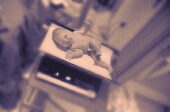| 
Teen Birth Rate Up in 26 States in 2006
 WEDNESDAY, Jan. 7 (HealthDay News) -- The teen birth rate in the United States increased in 26 of the 50 states in 2006, representing almost every region of the country, according to a new government report.
Back in December 2007, the U.S. Centers for Disease Control and Prevention reported that the teen birth rate for the entire nation had increased for the first time in 15 years in 2006 -- from 40.5 births per 1,000 women aged 15 to 19 in 2005 to 41.9 in 2006. Those statistics were based on 99 percent of all birth certificates in the United States for 2006, the agency said.
The latest report, released Wednesday by the CDC's National Center for Health Statistics, includes state-by-state teen birth rate statistics based on all birth certificates issued in 2006.
The report revealed that teen birth rates were highest in the South and Southwest, with the highest rate recorded in Mississippi (68.4), followed by New Mexico (64.1) and Texas (63.1).
Teen birth rates for 2006 were lowest in the Northeast, with the lowest rates in New Hampshire (18.7), Vermont (20.8), and Massachusetts (21.3), according to the report, Births: Final Data for 2006.
The only states reporting a decrease in teen birth rates between 2005 and 2006 were North Dakota, Rhode Island and New York, the report said.
The birth rate for teens 15 to 19 years old increased 3 percent in 2006, interrupting the 14-year period of continuous decline from 1991 through 2005. Only the rate for the youngest teens declined in 2006, to 0.6 per 1,000 females aged 10 to 14 years. The rates for teens 15 to 17 and 18 to 19 years old rose 3 to 4 percent each. These increases followed declines of 45 percent and 26 percent, respectively, in the rates between 1991 and 2005, according to the report.
Between 2005 and 2006, birth rates increased 3 percent to 5 percent each for non-Hispanic white, non-Hispanic black, and American Indian or Alaska Native teens and 2 percent for Hispanic teens. The rate for Asian or Pacific Islander teens was unchanged, the report said.
More information
For more on teen pregnancy visit the U.S. National Library of Medicine.
|  |

Circumcision Rates Too Low
 TUESDAY, Dec. 23 (HealthDay News) -- Thousands of male infants aren't being circumcised each year, because their states don't cover the procedure through Medicaid, new research suggests.
"There's a good case to be made that circumcisions can protect our children," said study author Arleen A. Leibowitz, a professor of public policy at the University of California, Los Angeles. "If you can alleviate the cost of the procedure, then people are more likely to adopt it."
Circumcision rates have been dropping since the 1980s amid controversy about whether the procedure is necessary or desirable. More states, meanwhile, have stopped paying for the procedure through Medicaid, including 10 in this decade alone. If all states covered circumcision, the percentage of male babies who get the procedure would rise from 56 percent to 62 percent, Leibowitz estimated.
Critics say circumcision is brutal and robs males of sexual sensation, but many in the medical community point to research that suggests circumcision reduces the risk of sexually transmitted diseases such as AIDS and the virus that can cause cervical cancer.
Currently, 16 states don't cover circumcision through their Medicaid programs, according to the new study. The procedure for an infant can cost $250 to $300, Leibowitz said.
Circumcision rates among Latinos are especially low, even if the government pays for the procedure, Leibowitz said. She added that rates are about equal among whites and blacks.
The study authors looked at a national sample of 417,282 newborn boys from 2004. The researchers examined the statistics with an eye toward whether the states where the boys were born covered circumcision.
The findings were published in the January issue of the American Journal of Public Health.
According to Leibowitz, the states that don't cover the procedure are: Arizona, California, Florida, Idaho, Louisiana, Maine, Minnesota, Mississippi, Missouri, Montana, Nevada, North Carolina, North Dakota, Oregon, Utah and Washington.
The researchers adjusted the numbers to account for factors such as the number of days that infants spent in the hospital. According to Leibowitz, it's difficult to fit in a circumcision if the baby is just there for a day.
Even with the adjustments, circumcision rates were significantly lower in states that didn't pay for the procedure through Medicaid, she said, adding that "not covering it under Medicaid sends a signal to recipients that this not a valuable procedure."
Robert C. Bailey, a professor of epidemiology at the University of Illinois at Chicago, said the poor are robbed of a chance to make a choice about circumcision because of the lack of funding.
"It's another way in which our health system is increasing inequality across the population," he said. "People who can't afford good health care are essentially being discriminated against by this policy."
More information
Learn more about circumcision from kidshealth.org  . .
|  |

Experimental Vaginal Gel Doesn't Ward Off HIV
 THURSDAY, Dec. 4 (HealthDay News) -- A microbicidal vaginal gel called Carraguard doesn't protect women from HIV infection.
That's the conclusion of a study that included more than 6,200 sexually-active, HIV-negative women at three sites in South Africa.
The women were given either Carraguard or a placebo gel and told to use one applicator of gel and a condom each time they had vaginal sex. The women, who were followed for up to two years, visited a clinic every three months to have tests for HIV infection and pregnancy, pelvic examinations, risk reduction counseling, and treatment for curable sexually transmitted diseases and vaginal infections.
The rate of HIV infection among women using Carraguard was 3.3 per 100-woman years, compared with 3.8 per 100-woman years in the placebo group. Rates of self-reported gel use were similar in both groups (96.2 percent Carraguard, 95.9 percent placebo), but applicator testing indicated that actual gel use was much lower (41.1 percent Carraguard, 43.1 percent placebo). Self-reported condom use was 64.1 percent for both groups.
The findings were published in this week's issue of The Lancet.
"This study did not show Carraguard's efficacy in prevention of male-to-female transmission of HIV, although no safety concerns were recorded. Low levels of gel use could have compromised the potential to detect a significant protective effect. Although the results from this and other completed microbicide efficacy trials have been disappointing, the search for female-controlled HIV-prevention methods must continue," wrote researchers from the Population Council in New York City and their colleagues.
Carraguard, a carrageenan-based compound, was developed by the Population Council.
In an accompanying comment, Dr. Willard Cates and Dr. Paul Feldblum, of Family Health International in North Carolina, wrote that no single method of HIV prevention will be adequate.
"Rather a combination of partly effective prevention approaches will be bundled into packages targeted to specific populations. This bundling will involve behavioral, biomedical, and structural interventions, each designed to reinforce the effect of the other. The cumulative influence of combination prevention is our hope for thwarting the spread of HIV," they said.
More information
The U.S. Centers for Disease Control and Prevention has more about HIV infection risk factors and prevention.
|  |

Placebo Acupuncture Tied to Higher IVF Pregnancies

THURSDAY, Nov. 13 (HealthDay News) -- Compared to real acupuncture, placebo acupuncture was associated with significantly higher overall pregnancy rates among women undergoing in-vitro fertilization (IVF), says a University of Hong Kong study.
In real acupuncture, fine needles are inserted into particular points on the body. In placebo acupuncture, blunt needles that look identical to real acupuncture needles retract into the handle of the needle when pressed on the skin, but still give the sensation and appearance of entering the skin.
The researchers gave real or placebo acupuncture to 370 women on the day of embryo transfer and found that 55.1 percent of those who received placebo acupuncture became pregnant, compared to 43.8 percent of those who received real acupuncture. The findings were published in the Nov. 13 issue of Human Reproduction.
"We found a significantly higher overall pregnancy rate following placebo acupuncture when compared with that of real acupuncture," study author Dr. Ernest Hung Yu Ng, an associate professor in the department of obstetrics and gynecology, said in a European Society for Human Reproduction and Embryology news release. "In addition, there was a trend towards higher rates of clinical pregnancy, ongoing pregnancy, live birth and embryo implantation in the placebo acupuncture group, although the differences did not reach statistical significance."
The results suggest that placebo acupuncture may not act as an inert control for real acupuncture and may be having a real effect. That theory is supported by the fact that the researchers noted significant changes in measurements for uterus receptivity and patient stress levels after the women received both the real and placebo acupuncture.
There are two possible explanations for the study results.
"Placebo acupuncture is similar to acupressure and therefore is good enough to improve the pregnancy rate," said Ng, who added it's also possible that real acupuncture may, in some way, reduce the pregnancy rate.
"So far, there is no evidence that real acupuncture would adversely affect IVF outcomes because, in a previous meta-analysis of several acupuncture studies, the pregnancy rate was higher in the acupuncture group than in the control group. However, we cannot draw a firm conclusion about this from our current study, as we did not compare the two groups with a third control group of patients who received neither form of acupuncture. Further studies should be conducted to compare placebo or noninvasive acupuncture and controls without acupuncture," Ng said.
More information
The U.S. National Center for Complementary and Alternative Medicine has more about acupuncture.
|  |
|